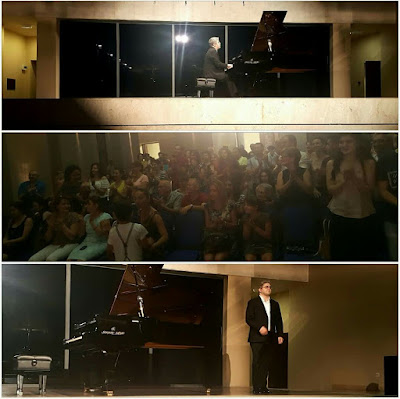 |
| Pianist Hrant Bagrazyan |
On July 19, accomplished classical pianist Hrant Bagrazyan gave a summer piano recital at the beautiful venue of the Komitas Museum-Institute, a "museum in Yerevan, Armenia, devoted to the renowned Armenian musicologist and composer Komitas", in memory of Professor Igor Yavryan, who passed away earlier this summer on June 16. Professor Yavryan was Bagrazyan's teacher and mentor.
 |
| Professor Igor Yavryan |
"He helped me love and appreciate classical music and shaped me as a musician", wrote Bagrazyan. "Without him I wouldn't become a pianist."
The house was completely full, even with the necessity of adding several extra chairs to the rows in order to fit everyone who showed up for the performance. This is not surprising considering the high quality of the performance given.
The stunning program consisted of Komitas'
Six Dances, Johannes Brahms'
Sonata No. 3 Op. 5 in f minor, Arno Babajanian's
Six Pictures, and Maurice Ravel's
Reflections.
 |
| Vardapet Komitas |
Komitas wrote the
Six Dances in 1906 in Paris, France, where he also performed them for the first time. In this dance cycle, Komitas realized "the richness of Armenian folk dances while preserving . . . the specific timbres of some national instruments" (
komitas.am). Each movement has its own name, describing the type of dance it is.
Erangi of Yerevan, an elegant woman's dance,
Unabi of Shushi, Marali of Shushi, Shushik of Vagharshapat, Het u Araj of Erzerum, "a men's round dance", and
Shoror of Erzerum, "a heroic men's dance". Although the pieces are written for piano, exquisite genius Komitas skillfully portrayed very specific and individual aspects of Armenian folk instruments. These instruments include, along with many others, the dap, tar, shvi, and dhol.
 |
Armenian Dhol
(Source: duduk.com) |
The national Armenian spirit in the Komitas was very well executed by Bagrazyan, and the six separate dances, although performed consecutively without much time in between, were very well distinguishable from one another by independent character and mood. Pianist Bagrazyan really kept the excited audience at the edge of their chairs.
 |
Armenian Tar
(Source: armradio.am) |
Brahms'
Piano Sonata No. 3 Op. 5 in f minor was written in 1853 and is exceptionally large for a sonata because of its five movements. Brahms was heavily influenced by the grandiose composer Ludvig Van Beethoven, to the extent that allusions to Beethoven's
Fifth Symphony are heard in Brahms' first, third, and fourth movements of his sonata. Brahms dedicated his sonata to Countess Ida von Hohenthal of Leipzig, and the composer was merely 20 years old when he composed it.
 |
| Johannes Brahms |
All movements of the Brahms were executed with an extreme sense of dynamics, that alternated between tumultuous passages and calm, serene passages, and exquisite technique. The emotional background that Bagrazyan gave during the performance of the Brahms was extremely envigorating to listen to. The Brahms, already explosive by its very nature, worked hand in hand with Bagrazyan's fiery performance of it, resulting in a combustion of colorful sparks.
Babajanian composed
Six Pictures for Piano
in 1965. "In addition to being a brilliant teacher, he was an ethnomusicologist, who imbued his students with a love for their native folk-music" (
naxos.com), and most of his compositions very cleary project their Armenian folk-music influence.
 |
| Arno Babajanian |
Bagrazyan's performance of Arno Babajanian's
Six Pictures was a splendid opening to the second half of the concert. The six separate movements,
Improvisation, Folk Song, Toccatine, Intermezzo, Choral, and
Sasoun Dance, were all performed by Bagrazyan with passion. The spirit of each movement was excellently manifested by Bagrazyan, who seemed to create a living, breathing character for each movement. In addition to the heightened level of emotion in his performance, Bagrazyan demonstrated his virtuosic and absolute piano technique.
 |
| Maurice Ravel |
Maurice Ravel composed his
Miroirs suite between the years of 1904 and 1906. In 1900, he joined a group of young and innovative artists, poets, critics, and musicians, called Les Apaches. Ricardo Viñes, the first performer of
Miroirs in 1906, called his fellow "artistic outcasts" "hooligans". Each of the five movements are dedicated to a member of the club.
Nocteilles (Moths) in D-flat Major is dedicated to Léon-Paul Fague;
Oiseaux tristes (sad birds) in E-flat minor is dedicated to Ricardo Viñes;
Une barque sur l'ocean (About on the Ocean) in F-sharp minor is dedicated to Paul Sordes and is considered the most difficult piece;
Alborada del gracioso (The Jester's Aubade) in D minor/major is dedicated to Michel-Dimitri Calvocoressi; and
La vallée des cloche (The Valley of Bells) in C-sharp minor is dedicated to Maurice Delage.
 |
Photos from the recital
PC: Ana Amirkhanyan |
Bagrazyan concluded his spectacular recital with Maurice Ravel's five-movement suite for solo piano
Miroirs (Reflections). The five movements, each of which is dedicated to one fellow member of the French avant-garde artist group, were performed by Bagrazyan with sincere emotional transparency. His superb technique, although extremely evident, was forgotten by the listener as it was drowned out by the magical portrayal of the imagery of each movement. The spectacular experience of these whimsical images was like an existential adventure into the very heart of basic human emotions. The audience was struck down by the power of the final performance, and the recital can
therefore be called a success.









Comments
Post a Comment